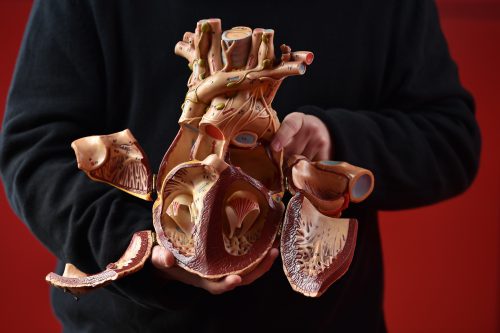To demonstrate the potential inherent in these models, the researchers from the Technion and Mambam developed a model of arrhythmia in ascending tissue. The model simulates the most common arrhythmia - atrial fibrillation - and makes it possible to examine the effect of relevant drugs in preventing the arrhythmia or stopping it after it has already developed

Researchers at the Technion and the Rambam Medical Center and their colleagues at UHN - the largest research hospital in Canada - succeeded in producing in the laboratory XNUMXD heart tissues engineered from induced human stem cells. The tissues, which simulate ascending and ventricular heart tissues, will be used in the near term to personalize medicines for heart patients and to develop new medicines for them. In the more distant future, the new technology is expected to be used in the production of implants for damaged areas of the heart's atria and chambers.
To demonstrate the potential inherent in these models, the researchers developed a model of arrhythmia in ascending tissue. The model simulates the most common arrhythmia - atrial fibrillation - and makes it possible to examine the effect of relevant drugs in preventing the arrhythmia or stopping it after it has already developed.
The research recently published in Nature Communications was led by Prof. Lior Gepstein, head of the Sonis Laboratory for Cardiac Electrophysiology and Regenerative Medicine at the Rappaport Faculty of Medicine and director of the heart department at Rambam Medical College, and doctoral student Idit Goldprecht. The work was done as part of a research collaboration between the Technion and UHN University in Toronto, and specifically with Prof. Gordon Keller's laboratory.
The main achievements presented in the current article are: First, if in a previous phase the research group presented progress from creating single heart cells from induced stem cells of patients to create a two-dimensional tissue, now a transition to a three-dimensional tissue has been achieved. Second, in the current study, the researchers measured both the electrical activity of the heart tissue obtained through a special system and the mechanical force that the system produces - a critical variable that significantly affects the normal activity of the heart. Thirdly, if in the past the group was able to produce tissue that is a "chaatense" of different heart cells, here the researchers were able to separately produce atrial cells and ventricular cells - two types of heart muscle cells (cardiomyocytes) that are critical to the heart's function but work differently.
"The separation between the two types of cells," explains Prof. Gepstein, "is important because drugs that improve the function of the atrial cells, and thus prevent atrial arrhythmias, may harm the function of the ventricular cells and even trigger ventricular arrhythmias. For example, in atrial fibrillation - the most common arrhythmia, responsible for more than a quarter of stroke cases - we want to use drugs to affect only the electrical activity of the atrial cells without harming the function of the ventricular tissue. Now that we can produce Alia cells and Chamber cells separately, we can test each drug on each cell type separately.
The unique research tools developed in the current study - engineered atrial tissue and atrial tissue, and innovative methods to study them - may bring about a revolution in the field of drug development as well as the ability to match drugs personally to the patient from whom the tissue was produced (personalized medicine). In the long term, Prof. Gepstein hopes, "we will be able to use similar methods to also produce heart tissues that will be used for transplants in heart patients. These tissues will be well absorbed because they are based on the genetic characteristics of the patient himself and not of a foreign donor."
The current article complements a previous study from Prof. Gepstein's laboratory, which was recently published in the leading cardiology journal Journal of The American College of Cardiology. In the same article, a unique two-dimensional model of heart tissue of human stem cell origin was described, which enables the study of arrhythmias in genetic diseases. In this work, carried out by Dr. Rami Shinoy and Naim Shahin from Prof. Gepstein's research group, the aforementioned model was used to study a dangerous genetic syndrome called the shortened QT syndrome. This syndrome can lead to a variety of arrhythmias and even sudden death in young patients. The model presented by Prof. Gepstein's group makes it possible to reproduce and study the resulting arrhythmia, to test different treatments in the laboratory and to choose in advance the optimal treatment for the specific patient. This work also demonstrated the possibility of using genetic editing (CRISPR) to correct the mutation leading to the arrhythmia.
The 2012D and XNUMXD engineered models described in these two articles are based on the creation of heart cells using human induced pluripotent stem cells (hiPSCs) technology. This technology was originally developed by the Japanese researcher Shiniya Yamanaka, winner of the Nobel Prize in Medicine for XNUMX. One of the outstanding advantages of this technology is the possibility of producing cells and tissues for transplantation from the patient's own body cells - which prevents the problem of rejection, which is typical for the transplantation of cells originating from another person. The process, in a simplistic description, begins with the collection of mature cells - skin cells, for example - from the patient. These cells undergo reprogramming in a sort of "cellular time tunnel" and are returned to the state of progenitor cells reminiscent of embryonic stem cells. Later, the stem cells are sorted in the laboratory into the desired tissue. In Prof. Gepstein's laboratory, which focuses on heart tissue growth, the researchers use different growth factors to direct the differentiation of the stem cells into heart cells, and as demonstrated in the last article, even into different types of heart cells: ventricle cells, ascending cells and pacemaker cells.
for the scientific article
